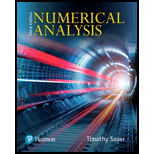
Numerical Analysis
3rd Edition
ISBN: 9780134696454
Author: Sauer, Tim
Publisher: Pearson,
expand_more
expand_more
format_list_bulleted
Concept explainers
Question
Chapter 9.4, Problem 9CP
To determine
To solve: For given Brownian motion SDE initial value problem with giving condition
Expert Solution & Answer
Want to see the full answer?
Check out a sample textbook solution
Students have asked these similar questions
Can you solve it numerical method
Use the information to find and compare Ay and dy. (Round your answers to four decimal places.)
Function
x-Value
Differential of x
Ду
=
dy
=
y = x² + 2
x = -4
Ax = dx = 0.01
The battery temperatures are a major concern for us. Can you analyze and describe the sample data? What are the average and median temperatures? How much variability is there in the temperatures? Is there anything that stands out?
Our engineers’ assumption is that the temperature data is normally distributed. If that is the case, what would be the likelihood that the Safety Zone temperature will exceed 5.15 degrees? What is the probability that the Safety Zone temperature will be less than 4.65 degrees?
What is the actual percentage of samples that exceed 5.25 degrees or are less than 4.75 degrees?
Is the manufacturing process producing units with stable Safety Zone temperatures? Can you check if there are any apparent changes in the temperature pattern? Are there any outliers? A closer look at the Z-scores should help you in this regard.
Chapter 9 Solutions
Numerical Analysis
Ch. 9.1 - Find the period of the linear congruential...Ch. 9.1 - Find the period of the LCG defined by a=4,b=0,m=9...Ch. 9.1 - Approximate the area under the curve y=x2 for 0x1,...Ch. 9.1 - Approximate the area under the curve y=1x for 0x1,...Ch. 9.1 - Prob. 5ECh. 9.1 - Prove that u1=x21+x22 in the Box-Muller Rejection...Ch. 9.1 - Implement the Minimal Standard random number...Ch. 9.1 - Implement randu and find the Monte Carlo...Ch. 9.1 - (a) Using calculus, find the area bounded by the...Ch. 9.1 - Carry out the steps of Computer Problem 3 for the...
Ch. 9.1 - Use n=104 pseudo-random points to estimate the...Ch. 9.1 - Use n=104 pseudo-random points to estimate the...Ch. 9.1 - (a) Use calculus to evaluate the integral 01x2x,...Ch. 9.1 - Prob. 8CPCh. 9.1 - Prob. 9CPCh. 9.1 - Devise a Monte Carlo approximation problem that...Ch. 9.2 - Prob. 1CPCh. 9.2 - Prob. 2CPCh. 9.2 - Prob. 3CPCh. 9.2 - Prob. 4CPCh. 9.2 - Prob. 5CPCh. 9.2 - One of the best-known Monte Carlo problems is the...Ch. 9.2 - Prob. 7CPCh. 9.2 - Prob. 8CPCh. 9.2 - Prob. 9CPCh. 9.3 - Design a Monte Carlo simulation to estimate the...Ch. 9.3 - Calculate the mean escape time for the random...Ch. 9.3 - In a biased random walk, the probability of going...Ch. 9.3 - Prob. 4CPCh. 9.3 - Design a Monte Carlo simulation to estimate the...Ch. 9.3 - Calculate the mean escape time for Brownian motion...Ch. 9.3 - Prob. 7CPCh. 9.4 - Use Itos formula to show that the solutions of the...Ch. 9.4 - Use Itos formula to show that the solutions of the...Ch. 9.4 - Use Itos formula to show that the solutions of the...Ch. 9.4 - Prob. 4ECh. 9.4 - Prob. 5ECh. 9.4 - Prob. 6ECh. 9.4 - Use the Euler-Maruyama Method to find approximate...Ch. 9.4 - Use the Euler-Maruyama Method to find approximate...Ch. 9.4 - Apply the Euler-Maruyama Method with step size...Ch. 9.4 - Prob. 4CPCh. 9.4 - Prob. 5CPCh. 9.4 - Prob. 6CPCh. 9.4 - Use the Milstein Method to find approximate...Ch. 9.4 - Prob. 8CPCh. 9.4 - Prob. 9CPCh. 9.4 - Prob. 10CPCh. 9.4 - Prob. 11CPCh. 9.4 - Prob. 12CPCh. 9.4 - Prob. 1SACh. 9.4 - Prob. 2SACh. 9.4 - Prob. 3SACh. 9.4 - Prob. 4SACh. 9.4 - Compare your approximation in step 4 with the...Ch. 9.4 - Prob. 6SA
Knowledge Booster
Learn more about
Need a deep-dive on the concept behind this application? Look no further. Learn more about this topic, subject and related others by exploring similar questions and additional content below.Similar questions
- Find the values of x and y in the following scalar multiplication. 8 2 x 1 3 || y = 9 LY_ Show Calculatorarrow_forwarda/ Solve the equation Laplac transfors wt = wxx W (X10)=0 w (o,t) = f (t) lim wexit) = 0 *>° t>o , to t70 848arrow_forwardQ/ Find the Fourier sine and cosine trans forms of f(x) = e-cxarrow_forward
- Calculus lll May I please have the statements completed for the following text lines and box? Thank you so much,arrow_forwardCalculus lll May I please have the solution for the following exercise? Thank you so mucharrow_forwardCalculus lll May I please have the solution for the following exercise? Thank you so much,arrow_forward
- Calculus lll May I please have the solution for the following exercise? Thank you so mucharrow_forwardCalculus lll May I please have the solution for the following example? Thank youarrow_forwardCalculus lll May I please have the statement completed for the following box? Thank you so much,arrow_forward
arrow_back_ios
SEE MORE QUESTIONS
arrow_forward_ios
Recommended textbooks for you
- Algebra & Trigonometry with Analytic GeometryAlgebraISBN:9781133382119Author:SwokowskiPublisher:Cengage

Algebra & Trigonometry with Analytic Geometry
Algebra
ISBN:9781133382119
Author:Swokowski
Publisher:Cengage
01 - What Is A Differential Equation in Calculus? Learn to Solve Ordinary Differential Equations.; Author: Math and Science;https://www.youtube.com/watch?v=K80YEHQpx9g;License: Standard YouTube License, CC-BY
Higher Order Differential Equation with constant coefficient (GATE) (Part 1) l GATE 2018; Author: GATE Lectures by Dishank;https://www.youtube.com/watch?v=ODxP7BbqAjA;License: Standard YouTube License, CC-BY
Solution of Differential Equations and Initial Value Problems; Author: Jefril Amboy;https://www.youtube.com/watch?v=Q68sk7XS-dc;License: Standard YouTube License, CC-BY